The Industrial Applicability of PEA Space Charge Measurements, for Performance Optimization of HVDC Power Cables
Abstract
1. Introduction
2. The Space Charge Accumulation Phenomenon
3. The Standard IEEE 1732-2017
- Cable heating. Specifically, the same temperature gradient at which the cable is designed to operate shall be created starting from 24 h before the measurement and maintained during the entire test;
- Positive voltage pooling time. Now the space charge measurement can start by applying a positive polarity rated voltage;
- First space charge measurement. After a few minutes of voltage application, the space charge distribution shall be acquired. This profile is constituted by only surface charges and is used as the reference;
- Subsequent measurements. After the “first measurement” and every 60 min until a time equal to 3 h a first series of space charge measurements shall be performed;
- Electric field evaluation. By taking into account the acquired space charge distributions during the “first measurement” and after 3 h of voltage application, the related electric field profiles (at 0 and 3 h) are determined. After that, the maximum absolute percentage variation between the two electric field profiles, ΔE, is calculated. If ΔE < 10% the electric field is considered stable and the subsequent step f can be neglected (go directly to point g). Otherwise, other space charge measurements are needed;
- In case of ΔE > 10%. The space charge measurements continue and they are acquired after 4, 5, and 6 h of voltage application. From the last measurement (at 6 h) the electric field distribution is determined and compared with that previously calculated after 3 h. As in the point e the maximum absolute percentage variation between the two electric field profiles is evaluated. Additionally, in this case, if ΔE < 10% go to point g, while, if ΔE is again greater than 10% repeat the space charge measurements for other 3 h. Therefore, after 7, 8, and 9 h of voltage application. Here, the maximum absolute percentage variation is calculated between the electric field at 6 and 9 h;
- Voltage removal. The cable conductor shall be short-circuited and grounded within a time no longer than 5 min from the voltage removal;
- Space charge measurement during volt-off. In this phase, the charge profiles are acquired immediately after the beginning of the depolarization time and then after 1, 2, and 3 h. For all acquisitions, the electric field profiles are also plotted, but only the relevant distributions are taken into account;
- The cable shall be left grounded for at least 24 h;
- Negative voltage pooling time. The space charge profiles, and the related electric field distributions are measured by applying a negative polarity rated voltage. The steps from c to h shall be repeated.
4. The PEA Method for Cables
5. Experimental Test on a Cable Specimen
6. Main Issues of the PEA Method for Cable Specimens
- The acoustic waves generated in the internal semiconductor/dielectric interface, before reaching the PEA cell, travel within the entire insulation layer. The latter, has both high thickness value (~20 mm) and high acoustic attenuation coefficient. Therefore, the information about the accumulated charge in this interface is characterized by a weak signal which, in some cases, could be confused with the measurement noise.
- the generated acoustic waves when travelling within both the cable specimen and the PEA cell are subjected to the reflection phenomenon. This is due to the different interfaces involved during the waves propagation. Specifically, when an acoustic wave reaches an interface, based on the acoustic impedance of the two materials in touch (e.g., dielectric and aluminum of the ground electrode), a part of the wave is transmitted and another part is reflected in the opposite direction. The reflected wave, after a certain time, is reflected again and directed towards the piezoelectric sensor. Based on this, the sensor detects both the main signal and its reflections. The latter signals, at least in our experimental test, fall within the main charge peaks and thus are a disturbance which do not allow the correct estimation of the accumulated charge.
7. The PEA Cell Model
8. Conclusions
Author Contributions
Funding
Acknowledgments
Conflicts of Interest
References
- Richardson, B.; Ramachandran, R. Enhanced energy efficiency of underground cables. In Proceedings of the IEEE PES T&D 2010, New Orleans, LA, USA, 19–22 April 2010; pp. 1–5. [Google Scholar]
- Fard, M.A.; Farrag, M.E.; McMeekin, S.; Reid, A. Electrical Treeing in Cable Insulation under Different HVDC Operational Conditions. Energies 2018, 11, 2406. [Google Scholar] [CrossRef]
- Xiong, L.; Chen, Y.; Jiao, Y.; Wang, J.; Hu, X. Study on the Effect of Cable Group Laying Mode on Temperature Field Distribution and Cable Ampacity. Energies 2019, 12, 3397. [Google Scholar] [CrossRef]
- Ahmed Dabbak, S.Z.; Illias, H.A.; Ang, B.C.; Abdul Latiff, N.A.; Makmud, M.Z.H. Electrical Properties of Polyethylene/Polypropylene Compounds for High-Voltage Insulation. Energies 2018, 11, 1448. [Google Scholar] [CrossRef]
- Powers, W.F. The basics of power cable. IEEE Trans. Ind. Appl. 1994, 30, 506–509. [Google Scholar] [CrossRef]
- Dissado, L.A.; Fothergill, J.C. Electrical Degradation and Breakdown in Polymers; Peregrinus Press: London, UK, 1992. [Google Scholar]
- Mazzanti, G.; Marzinotto, M. Space Charge in HVDC extruded insulation: Storage, effect, and measurement methods. In Extruded Cables for High Voltage Direct Current Transmission: Advances in Research and Development, Power Engineering Series; Wiley-IEEE Press: Hoboken, NJ, USA, 2013; pp. 99–207. [Google Scholar]
- Benato, R.; Balanuye, İ.; Köksal, F.; Ozan, N.; Özdemirci, E. Installation of XLPE-Insulated 400 kV Submarine AC Power Cables under the Dardanelles Strait: A 4 GW Turkish Grid Reinforcement. Energies 2018, 11, 164. [Google Scholar] [CrossRef]
- Bannach, D.; Kirchner, M.; Neubert, R. Retrofitting-new high voltage XLPE cables substituting paper-insulated power cables in steel pipes. IEEE Trans. Power Deliv. 1998, 13, 287–291. [Google Scholar] [CrossRef]
- Hanley, T.L.; Burford, R.P.; Fleming, R.J.; Barber, K.W. A general review of polymeric insulation for use in HVDC cables. IEEE Electr. Insul. Mag. 2003, 19, 13–24. [Google Scholar] [CrossRef]
- Kaminaga, K. Development of 500-kV XLPE cables and accessories for long-distance underground transmission lines. Long-term performance for 500-kV XLPE cables and joints. IEEE Trans. Power Deliv. 1996, 11, 1185–1194. [Google Scholar] [CrossRef]
- Chen, G.; Hao, M.; Xu, Z.; Vaughan, A.; Cao, J.; Wang, H. Review of high voltage direct current cables. CSEE J. Power Energy Syst. 2015, 1, 9–21. [Google Scholar] [CrossRef]
- Tang, C.; Huang, B.; Hao, M.; Xu, Z.; Hao, J.; Chen, G. Progress of Space Charge Research on Oil-Paper Insulation Using Pulsed Electroacoustic Techniques. Energies 2016, 9, 53. [Google Scholar] [CrossRef]
- Imburgia, A.; Romano, P.; Sanseverino, E.R.; Viola, F.; Hozumi, N.; Morita, S. Space charge behavior of different insulating materials employed in AC and DC cable systems. In Proceedings of the International Symposium on Electrical Insulating Materials (ISEIM), Toyohashi, Japan, 11–15 September 2017; Volume 2, pp. 629–632. [Google Scholar]
- De Araujo Andrade, M. Different Space Charge Behavior of Materials Used in AC and DC Systems. In Proceedings of the IEEE Conference on Electrical Insulation and Dielectric Phenomenon (CEIDP), Fort Worth, TX, USA, 22–25 October 2017; pp. 114–117. [Google Scholar]
- Maeno, Y.; Hirai, N.; Ohki, Y.; Tanaka, T.; Okashita, M.; Maeno, T. Effects of crosslinking byproducts on space charge formation in crosslinked polyethylene. IEEE Trans. Dielectr. Electr. Insul. 2005, 12, 90–97. [Google Scholar] [CrossRef]
- Suzuki, H.; Nozomu, A.; Miyake, H.; Tanaka, Y.; Maeno, T. Space charge accumulation and electric breakdown in XLPE under DC high electric field. In Proceedings of the Annual Report Conference on Electrical Insulation and Dielectric Phenomena, Shenzhen, China, 20–23 October 2013; pp. 250–253. [Google Scholar]
- Notingher, P.; Toureille, A.; Agnel, S.; Castellon, J. Determination of Electric Field and Space Charge in the Insulation of Power Cables with the Thermal Step Method and a New Mathematical Processing. IEEE Trans. Ind. Appl. 2009, 45, 67–74. [Google Scholar] [CrossRef]
- Imburgia, A.; Romano, P.; Caruso, M.; Viola, F.; Miceli, R.; Riva Sanseverino, E.; Madonia, A.; Schettino, G. Contributed Review: Review of thermal methods for space charge measurement. Rev. Sci. Instrum. 2016, 87, 111501. [Google Scholar] [CrossRef] [PubMed]
- Ala, G.; Caruso, M.; Cecconi, V.; Ganci, S.; Imburgia, A.; Miceli, R.; Romano, P.; Viola, F. Review of acoustic methods for space charge measurement. In Proceedings of the AEIT International Annual Conference, Naples, Italy, 14–16 October 2015; pp. 1–6. [Google Scholar]
- Mazzanti, G. A protocol for space charge measurements in full-size HVDC extruded cables. IEEE Trans. Dielectr. Electr. Insul. 2015, 22, 21–34. [Google Scholar] [CrossRef]
- Imburgia, A.; Miceli, R.; Riva Sanseverino, E.; Romano, P.; Viola, F. Review of space charge measurement systems: Acoustic, Thermal and Optical methods. IEEE Trans. Dielectr. Electr. Insul. 2016, 23, 3126–3142. [Google Scholar] [CrossRef]
- Rizzo, G.; Romano, P.; Imburgia, A.; Ala, G. Review of PEA Method for space charge measurements on HVDC cables and mini-cables. Energies 2019, 12, 3512. [Google Scholar] [CrossRef]
- Bodega, R.; Morshuis, P.H.F.; Smit, J.J. Electrostatic force distribution in a multi-layer dielectric tested by means of the PEA method. In Proceedings of the 2004 IEEE International Conference on Solid Dielectrics, 2004, Toulouse, France, 5–9 July 2004; Volume 1, pp. 264–267. [Google Scholar]
- Bodega, R.; Morshuis, P.H.F.; Smit, J.J. Space charge measurements on multi-dielectrics by means of the pulsed electroacoustic method. IEEE Trans. Dielectr. Electr. Insul. 2006, 13, 272–281. [Google Scholar] [CrossRef]
- De Araujo Andrade, M. Interpretation of PEA Output Signal in a Multilayer Specimen. In Proceedings of the IEEE Conference on Electrical Insulation and Dielectric Phenomena (CEIDP), Cancun, Mexico, 21–24 October 2018; pp. 101–104. [Google Scholar]
- Imburgia, A.; Romano, P.; Ala, G.; Riva Sanseverino, E.; Giglia, G. The Role of Right Interpretation of Space Charge Distribution for Optimized Design of HVDC Cables. IEEE Trans. Ind. Appl. 2019. [Google Scholar] [CrossRef]
- Romano, P.; Imburgia, A. Effect of Acoustic Wave Reflections on Space Charge Measurements with PEA Method. In Proceedings of the International Forum on Research and Technology for Society and Industry (RTSI), Palermo, Italy, 10–13 September 2018; pp. 1–6. [Google Scholar]
- Alatawneh, N. Effects of cable insulations′ physical and geometrical parameters on sheath transients and insulation losses. Int. J. Electr. Power Energy Syst. 2019, 110, 95–106. [Google Scholar] [CrossRef]
- Stancu, C. Computation of the Electric Field in Cable Insulation in the Presence of Water Trees and Space Charge. IEEE Trans. Ind. Appl. 2009, 45, 30–43. [Google Scholar] [CrossRef]
- Luo, K.; Yi, H.; Tan, H.; Wu, J. Unified Lattice Boltzmann Method for Electric Field–Space Charge Coupled Problems in Complex Geometries and Its Applications to Annular Electroconvection. IEEE Trans. Ind. Appl. 2017, 53, 3995–4007. [Google Scholar] [CrossRef]
- Mazzanti, G.; Marzinotto, M.; Castellon, J.; Chen, G.; Fothergill, J.; Fu, M.; Hozumi, N.; Lee, J.-H.; Li, J.; Mauseth, F.; et al. Recommended Practice for Space Charge Measurements on High-Voltage Direct-Current Extruded Cables for Rated Voltages up to 550 Kv; IEEE Standard Association (IEEE-SA): Piscataway, NJ, USA, 2017. [Google Scholar]
- Imburgia, A.; Romano, P.; Sanseverino, E.R.; De Rai, L.; Bononi, S.F.; Troia, I. Pulsed Electro-Acoustic Method for specimens and cables employed in HVDC systems: Some feasibility considerations. In Proceedings of the AEIT International Annual Conference, Bari, Italy, 3–5 October 2018; pp. 1–6. [Google Scholar]
- Bauer, B. Equivalent circuit analysis of mechano-acoustic structures. Trans. IRE Prof. Group Audio 1954, 2, 112–120. [Google Scholar] [CrossRef]
- Wang, X. Comparison and analysis of three pulse injection methods in the pulsed electroacoustic technique used for long cables. IEEE Electr. Insul. Mag. 2018, 34, 17–31. [Google Scholar] [CrossRef]
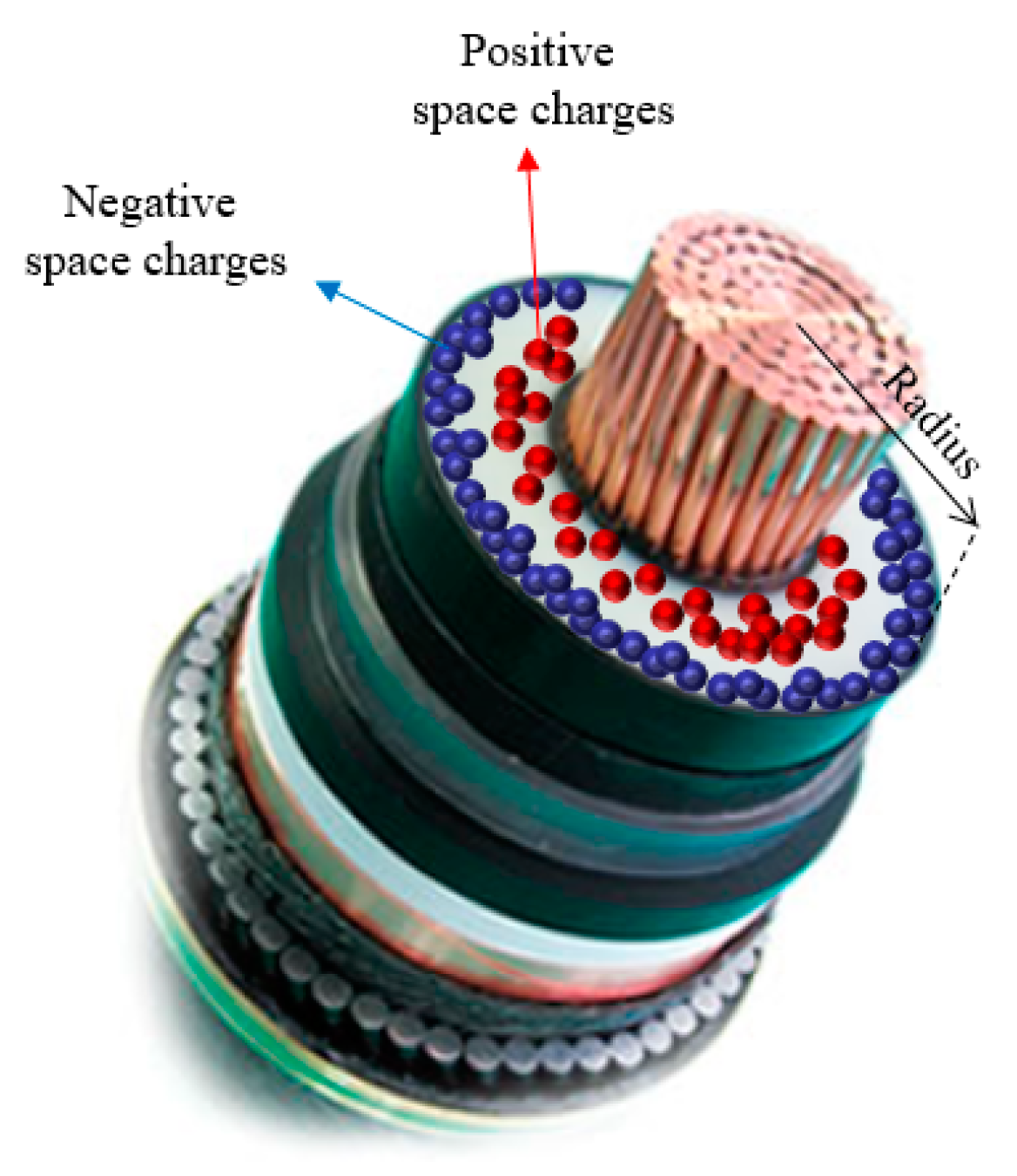

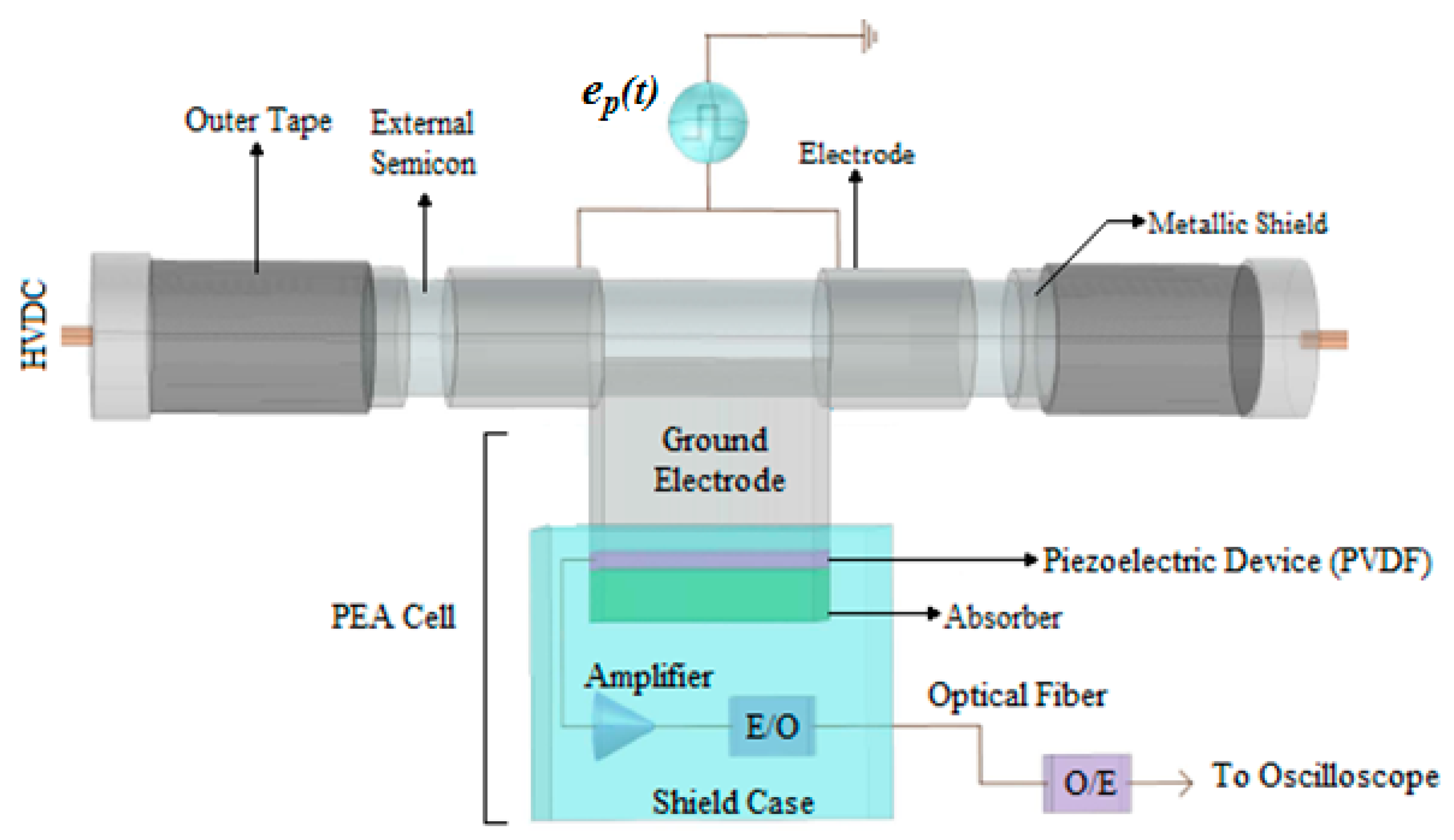


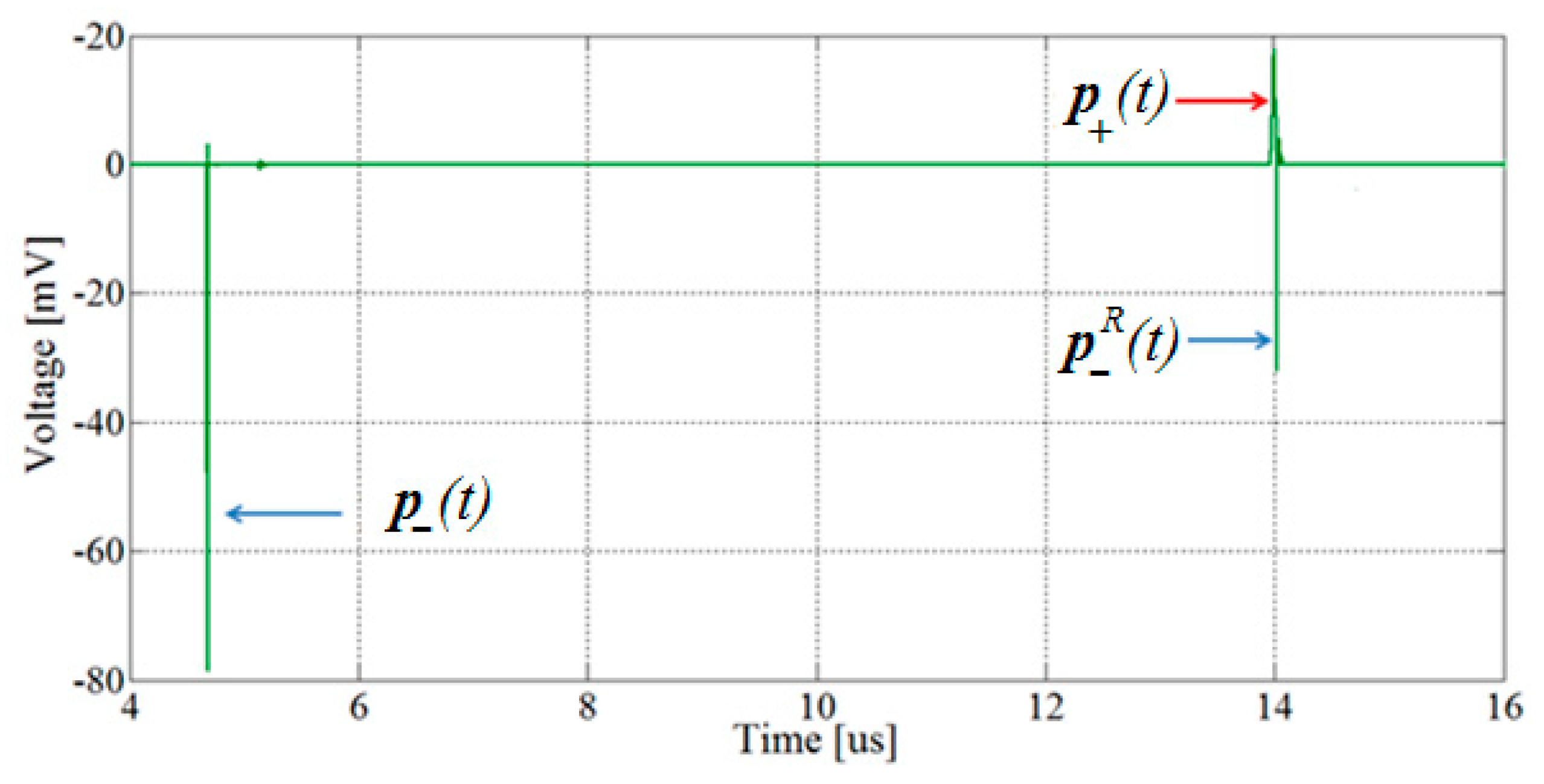
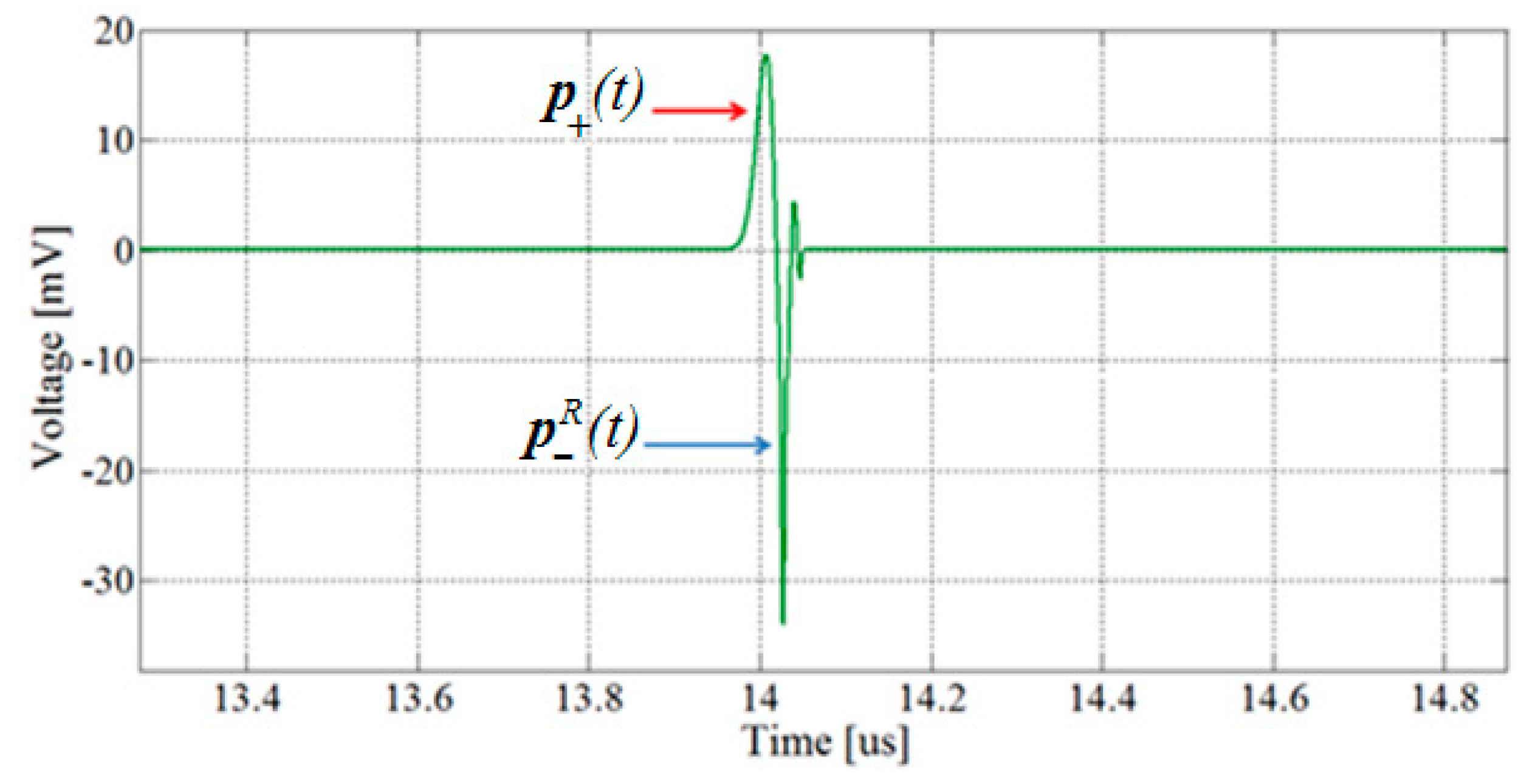
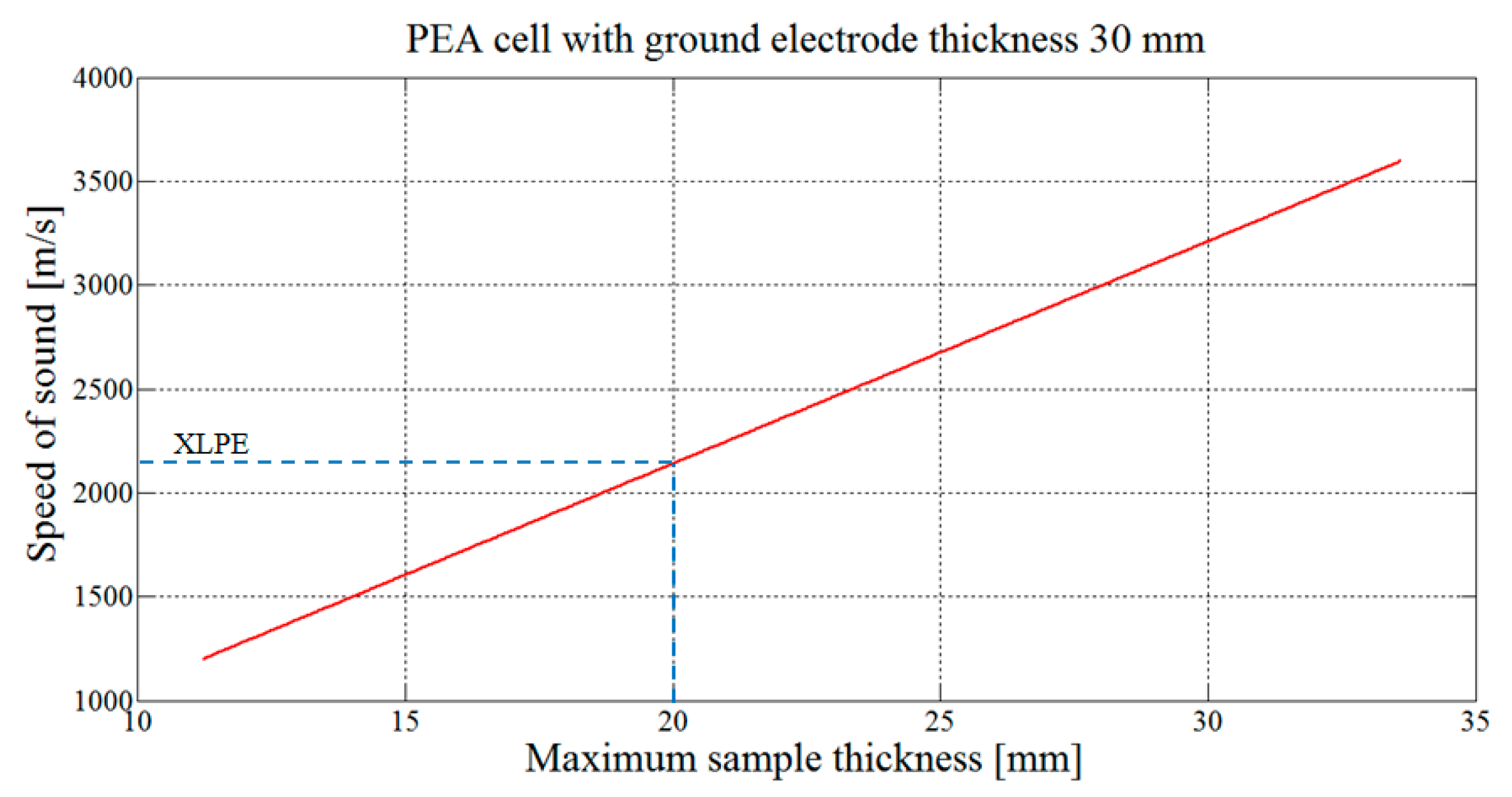

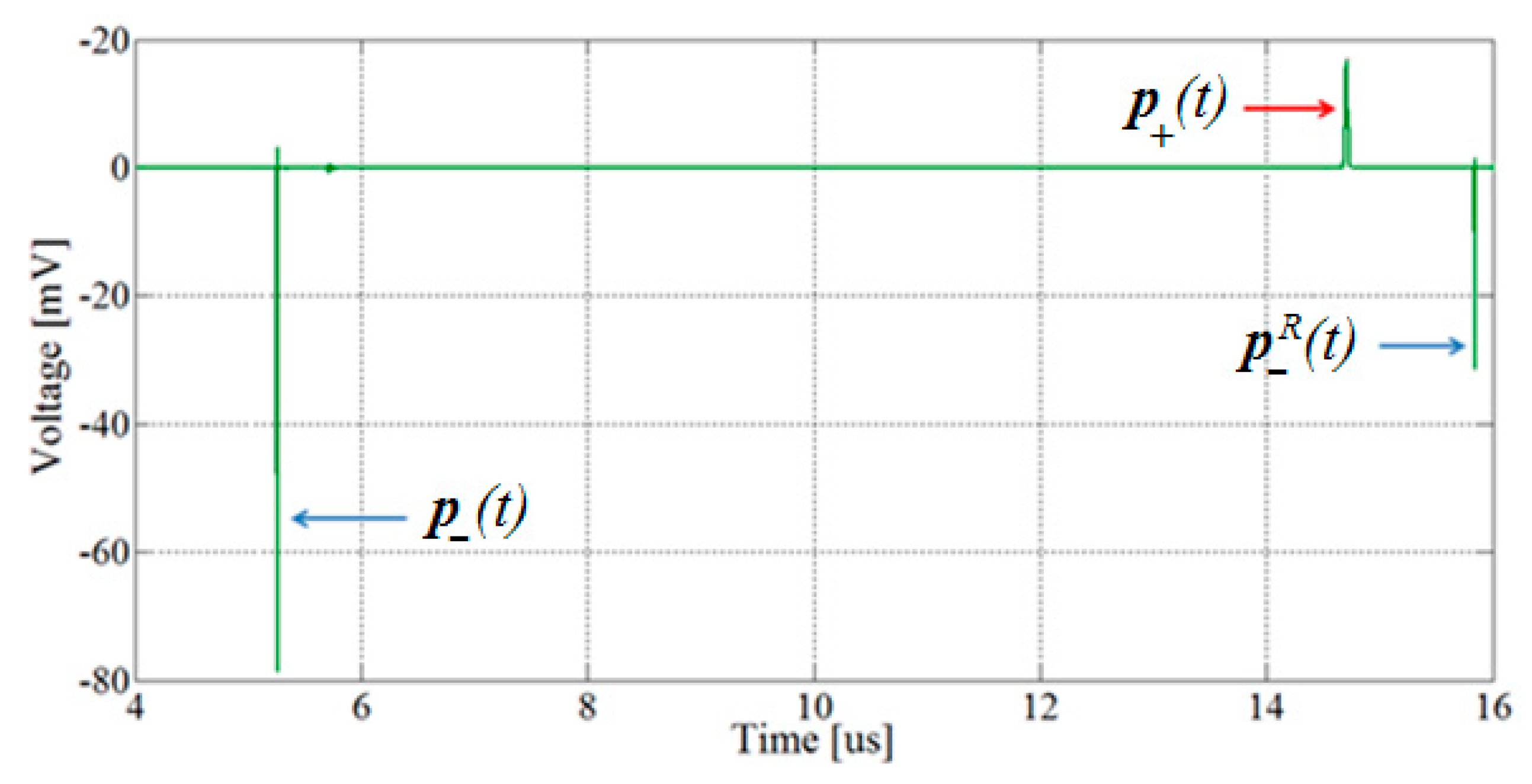
| Component | Layer | Material | Sound Speed (m/s) | Thickness (m) |
|---|---|---|---|---|
| Cable | Dielectric | XLPE | 2200 | 20 × 10−3 |
| Semiconductor | Semiconductor | ~2200 | 2 × 10−3 | |
| PEA cell | Ground Electrode | Aluminum | 6420 | 30 × 10−3 |
| Piezoelectric | PVDF | 2040 | 40 × 10−6 |
© 2019 by the authors. Licensee MDPI, Basel, Switzerland. This article is an open access article distributed under the terms and conditions of the Creative Commons Attribution (CC BY) license (http://creativecommons.org/licenses/by/4.0/).
Share and Cite
Imburgia, A.; Romano, P.; Chen, G.; Rizzo, G.; Riva Sanseverino, E.; Viola, F.; Ala, G. The Industrial Applicability of PEA Space Charge Measurements, for Performance Optimization of HVDC Power Cables. Energies 2019, 12, 4186. https://doi.org/10.3390/en12214186
Imburgia A, Romano P, Chen G, Rizzo G, Riva Sanseverino E, Viola F, Ala G. The Industrial Applicability of PEA Space Charge Measurements, for Performance Optimization of HVDC Power Cables. Energies. 2019; 12(21):4186. https://doi.org/10.3390/en12214186
Chicago/Turabian StyleImburgia, Antonino, Pietro Romano, George Chen, Giuseppe Rizzo, Eleonora Riva Sanseverino, Fabio Viola, and Guido Ala. 2019. "The Industrial Applicability of PEA Space Charge Measurements, for Performance Optimization of HVDC Power Cables" Energies 12, no. 21: 4186. https://doi.org/10.3390/en12214186
APA StyleImburgia, A., Romano, P., Chen, G., Rizzo, G., Riva Sanseverino, E., Viola, F., & Ala, G. (2019). The Industrial Applicability of PEA Space Charge Measurements, for Performance Optimization of HVDC Power Cables. Energies, 12(21), 4186. https://doi.org/10.3390/en12214186











